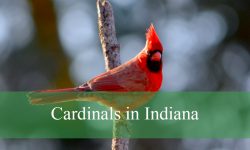Eastern North American moths are predominantly black and yellow in color. They frequently take on tricolored or opposing shapes and have complex black patterns combined with orange and yellow colors. Nonetheless, a few of these species may be regarded as pests since they endanger gardens and remove leaves from trees. In this article, we will explore more than 22 types of orange and black moths across North America.
Different Types of Orange and Black Moths
1. Hieroglyphic Moth
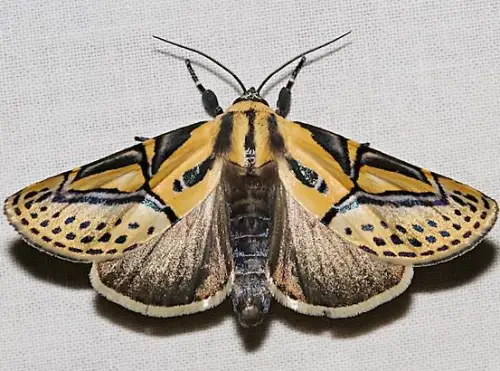
The US-native Hieroglyphic Moth (Diphthera festiva) is distinguished by its yellow forewings with black spots and stripes that mimic hieroglyphs. It grows well in Florida and Southern Georgia, where it is supported by pea plants and mallow. The species also has hindwings that are black and yellow, with brown variants occurring sporadically outside of the United States, from Central America to South America.
2. Obtuse Yellow
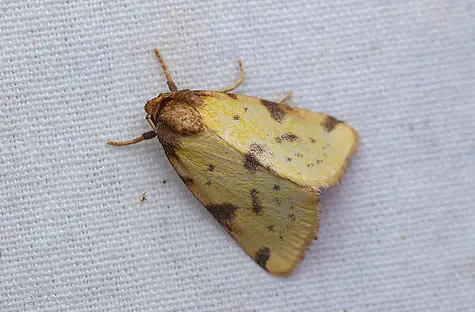
The tricolored Obtuse Yellow moth (Azenia obtusa) is native to the Eastern United States. It mimics the appearance of decaying yellow leaves. Its wings are dark yellow with dark brown borders and dots that contrast. The moth’s legs are a mixture of yellow, brown, and black, and its black head completes the overall color pattern. Tailored to the colors of its host plant, its eye-catching wings complement the hues of the giant ragweed.
3. Oak Leafshredder Moth
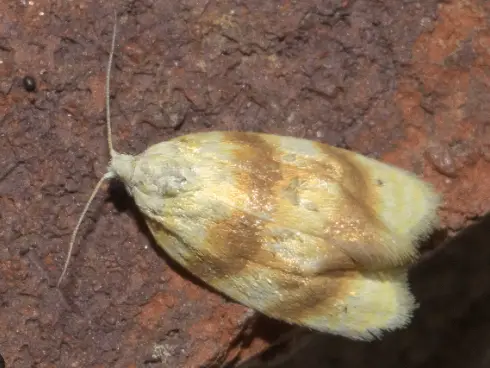
The native Oak Leafshredder Moth (Acleris semipurpurana) of North America affects oak trees in diverse ways. A few holes in the leaves, suggesting little damage, are indicative of mild instances; an exceptional loss of foliage indicates serious cases. These moths range in hue from golden yellow to lemon. There are multiple colors in the brown morph. They appear in yellow and either dark brown or black. Their habitat is in the eastern US and southeast Canada.
4. Half-Yellow Moth
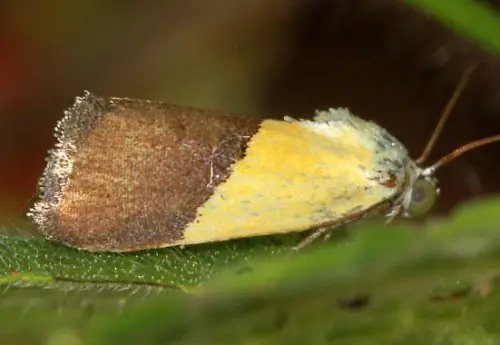
The Half-Yellow Moth (Ponometia semiflava) is distinguished by its eye-catching orange, brown, black, and yellow color scheme. The bright yellow that covers half of the forewings and contrasts with the black half is where the name comes from. The hindwings are mostly yellow-brown, although the body is a mixture of dark and bright colors. This species has a beautiful mixture of hues and a short season that in its northern distribution ends in midsummer.
5. Thin-Banded Lichen Moth
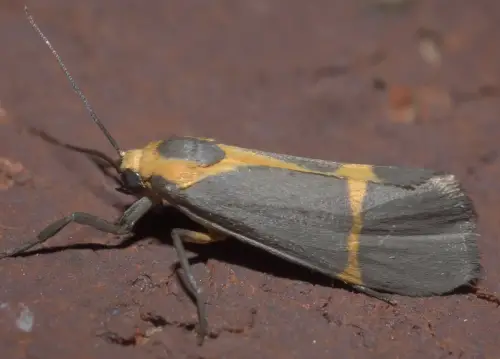
The primary color scheme of the Thin-Banded Lichen Moth (Cisthene tenuifascia) is yellow, orange, and black. Its caterpillars, in particular, have a fondness for lichen. These moths are primarily black in color, with vivid orange and yellow markings on their wings. With a characteristic yellow-orange vertex, they usually appear in March and stay active until the early fall. They can be found thriving from Arizona to Florida in the Southern states of the United States.
6. Packard’s Lichen Moth
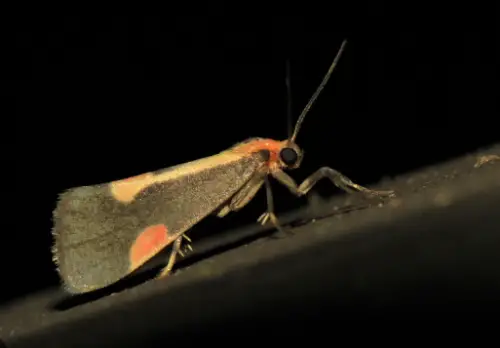
The Packard’s Lichen Moth, or Cisthene packardii, is a woodland species that can be found across the upper states and parts of New York. These moths, which are known to eat lichens, are usually found in parks and forests. They have wings that are colored in various shades of black, yellow, orange, pink, or red. The forewings are mostly black, but variations in pale yellow or cream highlight the detailed patterns. Occasionally, splashes of pink, orange, or crimson adorn the vivid wing patterns. Their activities take place over a brief season in the northern states, which lasts until August, and almost all year long in the southern states. mostly found to the east of the Rocky Mountains.
7. Texas Wasp Moth
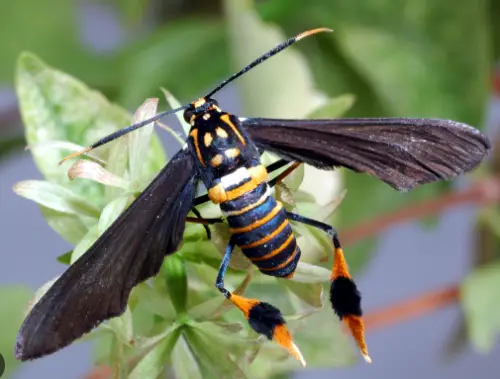
With its long body and thin wings, the Texas Wasp Moth (Horama panthalon) resembles wasps in both look and behavior. It is mostly black with distinct bands of orange and yellow, and it has long antennae and black wings. Its legs have amazing orange and black combinations, and there are variations as well, like a yellow and black or an orange and black morph. Its vivid coloring is determined by the flowers it frequents, and its wingspan often measures between one and two inches. found in the West Indies, Central America, South America, Texas, Arizona, and New Mexico.
8. Nais Tiger Moth
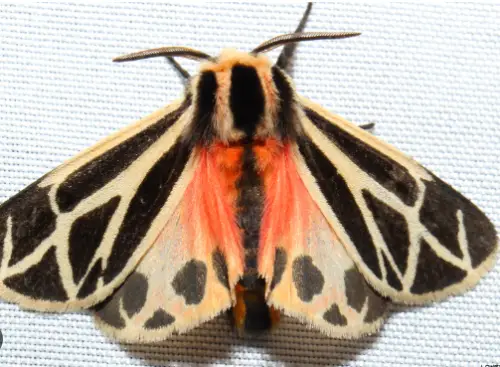
The Nais Tiger Moth (Apantesis nais) is attracted to flowers and grasses; it lives in fields with open grass and forests. They have stunning appearances; their forewings are primarily black and white or cream and black. Their body is a deeper mix of black and yellow, with the hindwings having a yellow undertone. Near the crown, some examples have subtle yellow-orange tones. Active in the spring, summer, and fall, these overwintering moths are found in several US states and their range extends to Canada east of the Rocky Mountains.
9. Confused Haploa Moth

The Confused Haploa Moth (Haploa confusa) is characterized by its many hues, which are mostly white, and by the various embellishments on its forewings and hindwings, which range from brown to black. The head and wings have portions that are orange and yellow. Its caterpillars also exhibit black and yellow pairings, sometimes in cream variations. It lives mainly in the northeastern United States and often visits dog’s tongues, feeding on weeds and wildflowers.
10. Ornate Tiger Moth
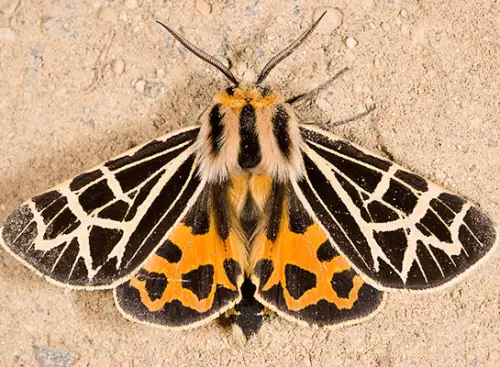
The vivid yellow, orange, and black hues are displayed by the tricolored Apantesis ornata, often known as the Ornate Tiger Moth. Its hindwings feature an eye-catching orange and black combination, while its bright yellow and black forewings are ornamented with intricate black designs. This species is found in roadsides, forests, and prairies in the northern US states and Western Canada. Regional differences show up as a variety of wing patterns; some are restricted to yellow and black. The color patterns of the hindwings may notably resemble those of the forewings.
11. Virgin Tiger Moth
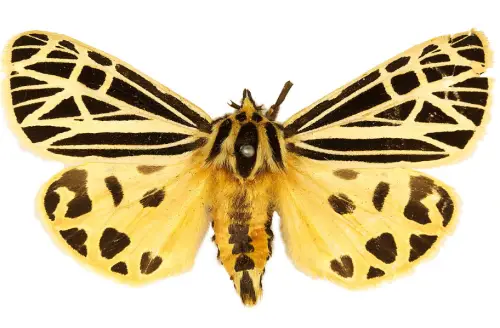
The Virgin Tiger Moth (Apantesis virgo) exhibits a range of colors, with vivid yellows and oranges frequently taking center stage. It comes in variants that are either yellow and black or yellow and orange, and certain individuals even have crimson red hindwings. The hindwings may have the same color combinations as the forewings, which are primarily yellow and black. The hindwings have minimal black patterns, whilst the body is a mix of yellow and black. The northeastern United States is the species’ primary habitat.
12. Black-And-Yellow Lichen Moth
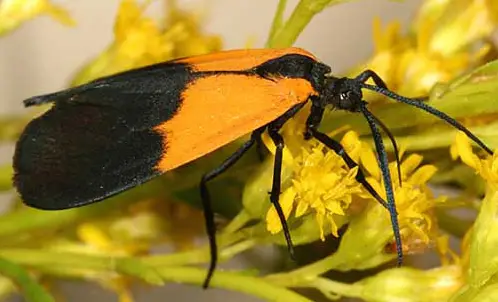
Bright yellow-orange and black colors characterize the Black-and-Yellow Lichen Moth (Lycomorpha pholus). Its hindwings are mostly black with flashes of yellow or orange, but its forewings are an intriguing combination of black and yellow or orange. This species migrates from egg to adulthood over a period of years, feeding on lichen. This moth, which has larvae with bands of black and yellow that alternate, is almost an inch long and spreads its wings over a large area in Eastern Canada and Eastern USA.
13. Orange-Spotted Flower Moth

The Orange-Spotted Flower Moth (Syngamia florella) boasts a vivid color trio of orange, yellow, and black. Sporting yellow and black wings, its upper body exhibits intricate patterns of the same colors. The hindwings mirror this design. A distinct orange hue characterizes the lower part of its body. Known to thrive in the Southeastern United States, this species finds hosts in various plants, including the West Indian Buttonweed.
14. Common Spragueia Moth
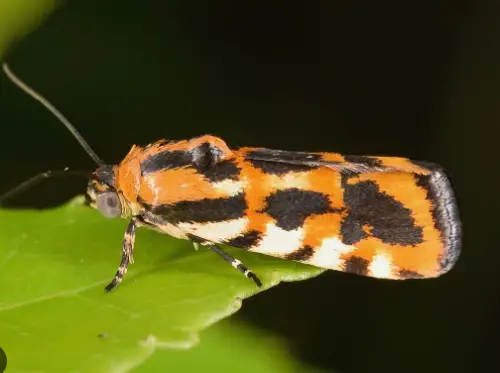
With wingspan as short as 0.7 inches, the Common Spragueia Moth (Spragueia leo) is captivating due to its vivid forewings. The vivid orange base has black and yellow specks scattered throughout, with black patterns and edges drawing attention to the orange and yellow hues. Without the black patterning of the forewing, the hindwings have a tan to brown tone. This species, which is native to the United States, may show variations in brown, white, and black. It grows well in the Southeastern region of the US.
15. Bedstraw Hawkmoth
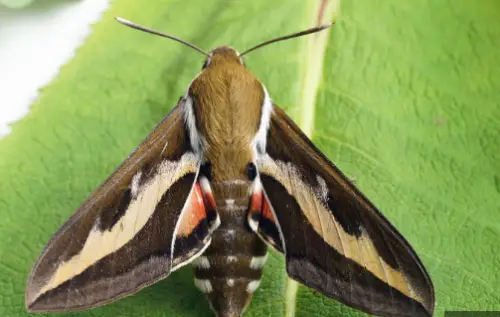
The bright combination of orange, yellow, and black colors is exhibited by the Bedstraw Hawkmoth (Hyles gallii). Its wings are a remarkable mix of yellow, pink-orange, and black, with definite black borders. It feeds on nectar and has hairy, olive-brown bodies. Both weeds and ornamental blooms are among the plants that these moths consume. Primarily inhabiting coniferous woodlands in the northern US and southern Canada, they also live in locations where lilac is present, which is a preferred source of nectar. During their last growing stage, their readily identifiable caterpillars change from an olive hue during earlier stages to a black body with eyespots that are either yellow-orange or pink.
16. Orange-Patched Smoky Moth

One of the various black moth species found in North America is the Orange-Patched Smoky Moth (Pyromorpha dimidiata), which is primarily black with accents of orange or yellow. Their presence in gardens and crops indicates possible harm to the softer outer vine leaves, which could hinder plant growth. They are known to feed on a variety of vines. Their aposematic hues act as a warning, discouraging natural predators, and they are active from March to August. The eastern United States is the primary home of these moths.
17. Leconte’s Haploa Moth
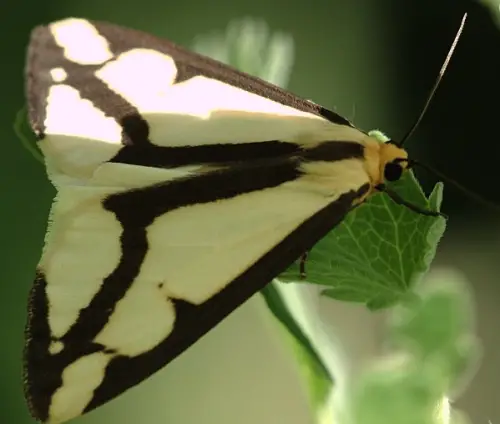
The high-contrast patterns of Leconte’s Haploa Moths (Haploa lecontei) are observed in forests and nettle-rich environments. They come in a variety of morphologies, but their two primary hues are still black and white. There are black markings and edges on the white wings, and orange, yellow, or yellow-orange hues on the head. This species is often seen in gardens, parks, and wooded areas. It can be identified by its almost black caterpillar with extra yellow bands. It may also eat the fruits or leaves of different hardwood trees when it is in a garden. Its natural habitat is found in the eastern United States.
18. Bold-Feathered Grass Moth
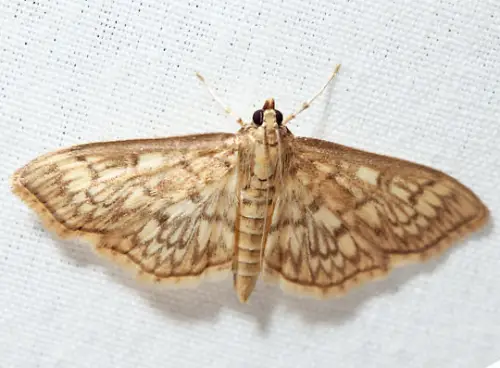
The Bold-Feathered Grass Moth (Herpetogramma pertextalis) features a striking combination of yellow and black hues, often in pale yellow shades with distinct gray or black wave patterns across its wings. Some specimens exhibit golden-yellow variations on both wings and body. True to its name, this species lays eggs in grass, with bright caterpillars commonly found in lawns and gardens. While it feeds on grass, its impact on lawns remains relatively minor compared to other caterpillars. Additionally, Black-Feathered Grass Moth caterpillars can also consume various plants and flowers. This species is distributed across the United States.
19. Harnessed Tiger Moth
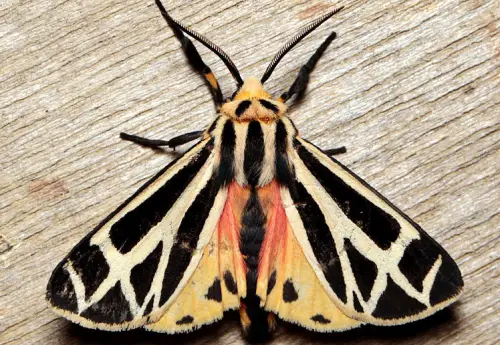
The frequent visitors to maize and clover fields, the Harnessed Tiger Moth (Apantesis phalerata), pose serious risks to North American agriculture. Controlling large populations is essential to reducing crop damage. These moths are easily recognized by their striking appearance. They are available in tricolored, orange and black, or yellow and black variants. The tricolored morph has forewings that are yellow and black, and hindwings that are a mix of black, yellow, and orange. The forewings and hindwings have different black patterns, with the former having more black parts and the latter having a narrower black border. They are found throughout Eastern North America.
20. Eight-Spotted Forester Moth
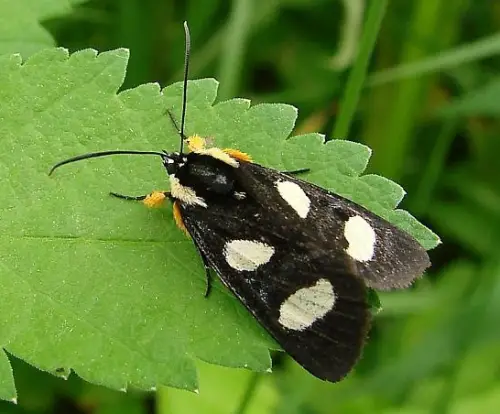
The eye-catching color scheme of the Eight-Spotted Forester Moth (Alypia octomaculata) is black, yellow, and orange. Its foldable wings are mostly black with noticeable orange and yellow dots. With mostly black antennae and orange and black legs, these moths usually have a maximum wingspan of 1.2 inches. Their caterpillars are colored in striking contrasts of orange, black, and white. They are widespread in the US South and Southeast and eat a variety of garden vine leaves. This species is active in the early spring and may reproduce once or twice a year. Their habitat is found in the Southern United States, the Eastern United States, and Canada.
21. Black-Bordered Lemon Moth
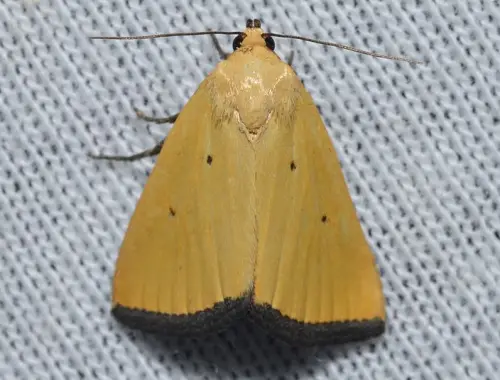
The Black-Bordered Lemon Moth (Marimatha nigrofimbria) has unique color combinations of orange and yellow or black and yellow. brilliant yellow or brilliant orange in base color, these morphs only have black markings on their forewings, including dots and borders. The margins of the hindwings are paler than those of the forewings, and they are either dark orange, brown, or dark yellow. These moths, which have a wingspan of up to 0.8 inches, are common in the Eastern and Southern regions of the United States. They can be seen in Texas through November.
22. Ailanthus Webworm Moth
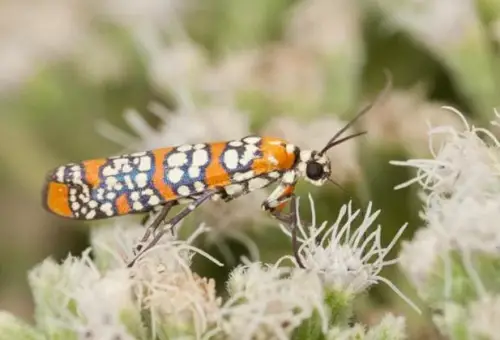
The Ailanthus Webworm Moth (Atteva aurea) is found in the southern United States. Its wings are a unique combination of orange, yellow, and black coloration. Its mainly orange forewings can be distinguished from its hindwings by their black-bordered yellow dots. These yellow patches differ in size depending on the area. The hindwings have gray edges and a smoky-white hue. Remarkably, the moth’s body is divided into sections that are yellow, orange, and dark gray, suggesting that it prefers the tree of paradise, a tropical species that is spreading over North America. Its habitat extends from China and South America to Florida and Central America.
People Who Read This Also Read:




